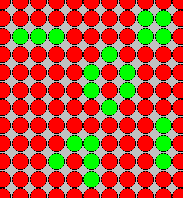


The Computer as a Telescope/Microscope:
Computing and Research
Computing and Research

| 
| 
|
Computing and Research | ||
While contemporary attention is currently focused largely on the role of computing in the "information revolution" and its accompanying social and commercial significance, computing has always had and continues to have an additional (and, in the long run, perhaps even more important) significance:
At Bryn Mawr College, the research programs of a number of faculty members reflect this characterization of computing as a revolutionary research tool. Materials on this and linked pages are provided as a contribution to informed discussion of the role of computing in the life of the College (and in the wider world), and of ways to best take advantage of its evolving capabilities.
A partial list of relevant Bryn Mawr faculty and staff:
In the past fifteen years or so, my research has come to rely almost completely on computers. My interests are in the development and testing of computational tools for the study of signals that display complexity in their spatial distribution as well as in their temporal evolution, and the use of these tools for the analysis of biological or biomedical signals.
The research in my laboratory focuses on elucidating the neuronal bases of animal behavior. Specifically, I am interested in how neuronal networks in the central nervous system of the leech produce the motor program for swimming. Computers are tools I use to perform a number of tasks to acquire, analyze and display neurophysiological data (voltage signals). To accomplish these tasks, I've been using the hardware and software (SuperScope) from GW Instruments. SuperScope basically emulates a digital oscilloscope with programing capability. Programing in SuperScope consists of writing tasks (calling up subroutines) that control the A/D board, save files and manipulate files.
SuperScope Task examples:
1. Latency measurements
2. Signal averaging
3. Statistical analysis
4. Period and duration
5. Spike
counts
The mechanical interaction of normal faults plays a significant role in the organization of faults into fault systems. My on-going work investigates perturbations in the local stress field around normal faults via numerical experiments using the boundary element method. Three dimensional visualization of the stress fields is important for evaluating the model results and for building intuition about the behavior of faults. The modeling is motivated by field study of Miocene normal-fault scarps in the northern Basin and Range province of Oregon, and results yield insight into the distribution of aftershocks of the 1993 Klamath Falls, Oregon, earthquake sequence.
My serious engagement with computers dates from the appearance of the Macintosh in 1984, and my discovery that computing had reached the point where one no longer had to know in advance what one wanted a computer to do. The increased speed and improved interfaces of a fundamentally "logical" machine made it possible to discover interesting things by "fiddling", by simply trying things out to see what would happen. It was this paradoxically inductive capability that turned the computer, for me, from a relatively uninteresting "analytic" device to a tremendously exciting "exploratory" one.
I initially began using computers in research in connection with my then and continuing interests in brain organization. Neural nets, modelled on computers, yield important insights both into how particular brains work and into broader question such as the nature and origins of knowledge. I continue to work in this area, both modelling aspects of nervous system organization on computers, and thinking about computing itself as a "model" of how the brain works.
The major impact of computing on my research program, however, has been not so much as a new tool to approach existing questions but rather as an incentive to ask new questions. Or, to some extent, to entertain anew the ambition to approach old questions that previously seemed unapproachable. I (like a number of other people) see similarities in difficult to understand phenomena across a wide range of disciplines, suspect that these relate to some generalizable principles of "complex systems", and believe that computer modelling provides the essential tool to explore this terrain. Among the issues which interest me are how systems evolve from less ordered to more ordered states, the role of randomness in such evolutionary processes, and the reality/significance of distinctions between randomness and other forms of disorder
Computing has also contributed, for me, to a productive blurring of the border between research and teaching. The creation of virtual exhibits makes possible forms of teaching in which students can themselves more directly experience the observations which yield particular understandings, and the creation of such exhibits in turn generates new questions for further research (cf Three Doors to Understanding). To bring the matter full circule, we have recently been exploring the creation of virtual worlds which can be used both as educational experiences and tools for collection of new observations on human brain function (cf. Serendip's House).
Computers have made available large and continually updated socio-economic databases from which information can easily be acquired over the internet for subsequent computer-facilitated statistical analyses. Using these capabilities (particularly the Panel Study of Income Dynamics, a longitudinal survey of a representative sample of US individuals and the families in which they reside), I am exploring the relationships between a variety of socio-economic factors and life trajectories.
Some recent publications: